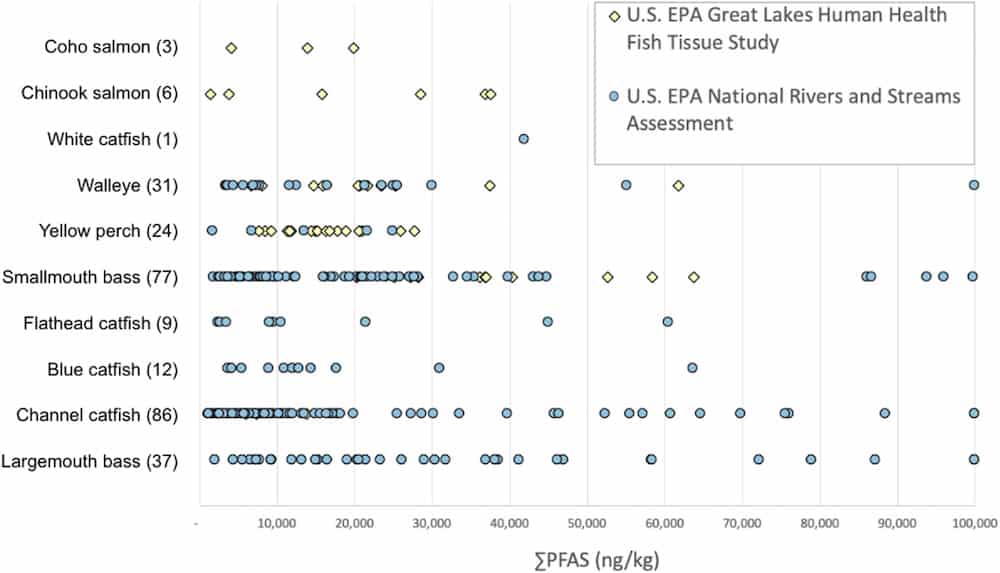Feature
Maine Was First to Ban Spreading PFAS-Contaminated Sludge on Farmland. Now Sludge Is Filling up Landfills.
Health•19 min read
Analysis
New research finds significantly higher levels of PFAS in locally caught freshwater fish than store-bought fish.


Words by Grace Hussain
Locally caught freshwater fish are a significant source of “forever chemicals” in the U.S. according to a new study conducted by Duke University and Environmental Working Group researchers.

The study authors compared concentrations of perfluorooctane, or PFOS, in wild, locally caught freshwater fish and fish sold in grocery stores, and the results were alarming — PFOS levels were significantly higher in the freshwater fish.
Perfluorooctane is a specific type of PFAS, which stands for per-and polyfluoroalkyl substances. PFAS have earned the dubious nickname “forever chemicals” because of their ability to stick around in the environment for centuries or even longer — some for more than a thousand years. This particular contaminant has been linked to higher cholesterol, attention deficit/hyperactivity disorder and infertility.
PFAS or “forever chemicals” have been used in manufacturing since the 1940’s. There are thousands of different types of PFAS. Some can repel water and oil, and are typically used in products like food packaging and stain-resistant fabrics. But there are significant downsides — these chemicals persist in the environment and have been linked to health problems like cancer, high blood pressure in pregnant women and developmental delays in children.
The researchers compared PFOS levels in fish filets based on EPA and FDA data, and found that the concentrations of total PFAS were significantly higher in freshwater fish than in fish sold at the grocery store.
What’s more — consuming just one 8 oz serving of freshwater fish was the same as drinking a month of water contaminated with PFOS at a level 2400 times the EPA health advisory.
On the other hand, consuming one serving of fish purchased from a store was equivalent to a month of drinking PFOS-contaminated water at a level only 5.7 times greater than the EPA health advisory. In fact, researchers found that a person eating locally caught freshwater fish even just once a year would have the same PFAS blood levels as those consuming store-bought fish on a weekly basis.
Still, even though the levels of PFOS in locally caught fish were much higher than those in purchased filets, it’s important to note that both contained forever chemicals in amounts greater than those recommended by the EPA for drinking water.
This study builds on previous research of PFAS from fresh-caught fish: a 2014 study of 478 French city dwellers found participants who consumed large amounts of fresh-caught fish had higher levels of PFAS in their bloodstreams than those that consumed no fresh-caught fish, or even very little. The CDC believes 98 percent of Americans have PFAS in their blood, though levels of these chemicals have been trending downward.
While the EPA does provide a daily maximum PFOS recommendation, there are no federal consumption guidelines relating to forever chemicals in fish. Fourteen states do provide consumption advisories for fish contaminated with forever chemicals, but many guidelines rely on outdated EPA guidance that cited a much higher maximum acceptable exposure, according to the researchers. If state recommendations were updated to reflect the agency’s 2022 exposure guidance — which is three orders of magnitude lower — almost all of the fish reviewed by the EPA would be considered unsafe.
This new study challenges the popular assumption that fresh, locally caught fish are better for you than farmed fish. In reality, both may be detrimental to personal and public health.
Most fish farms heavily pollute surrounding waters and spread disease to wild marine species. Meanwhile, commercial fishing contributes to algal blooms and plastic pollution.
Yet the study’s findings are particularly worrisome for communities who catch and rely on large amounts of fish for sustenance in the U.S., including many Indigenous and immigrant populations. After experiencing generations of discriminatory government policies and exposures to other industrial pollutants, the presence of high levels of forever chemicals in what is a primary food source is of grave concern. Reducing exposure to forever chemicals should therefore be a top public health priority, the study authors urge, a matter of both social and food justice.